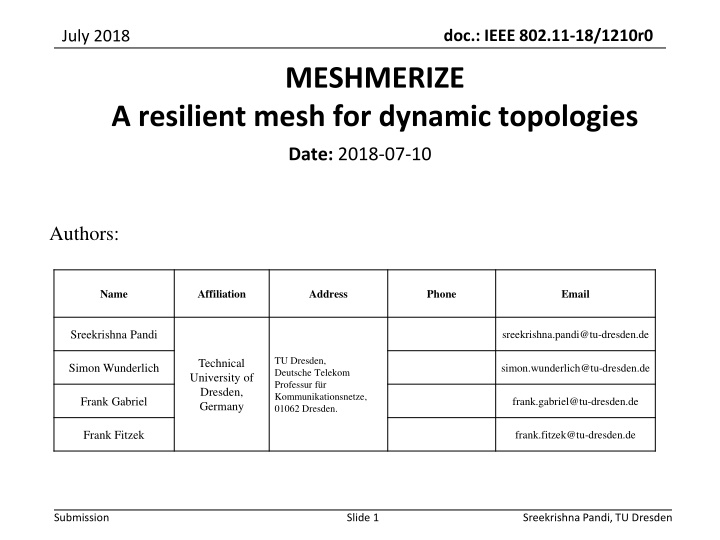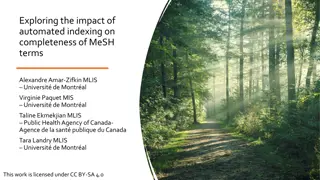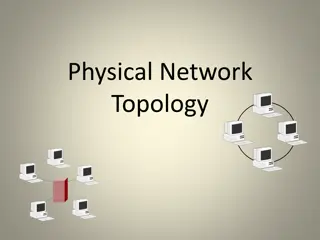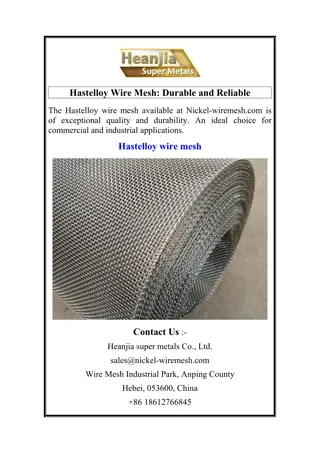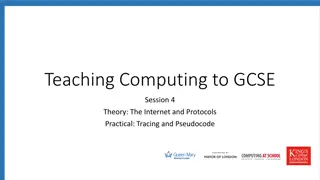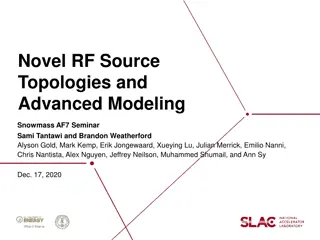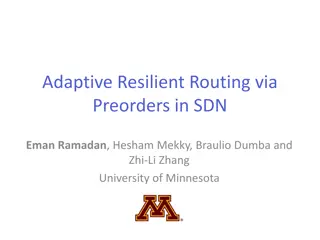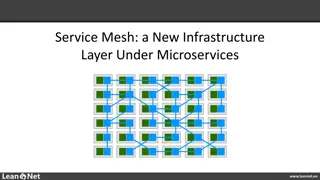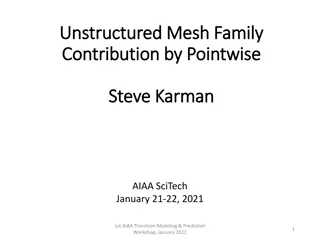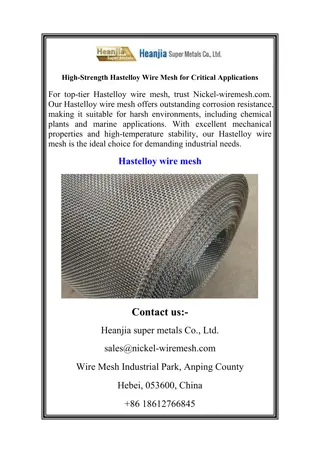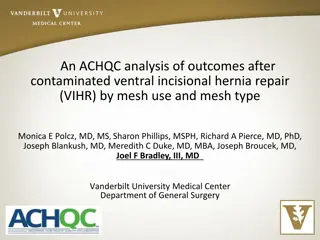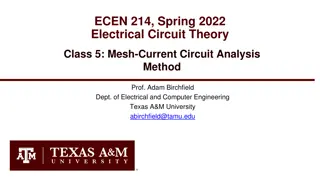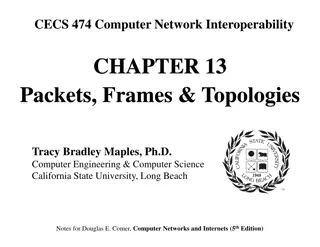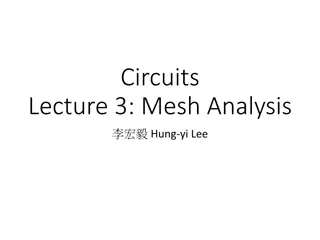MESHMERIZE: A Resilient Mesh for Dynamic Topologies
This document presents research on a novel mesh routing protocol called Meshmerize, designed for dynamic networks like 5G applications and scenarios where cellular connectivity is limited. Meshmerize utilizes opportunistic routing and advanced coding techniques to achieve high resilience, low latency, and ideal throughput-resilience trade-offs.
Download Presentation

Please find below an Image/Link to download the presentation.
The content on the website is provided AS IS for your information and personal use only. It may not be sold, licensed, or shared on other websites without obtaining consent from the author.If you encounter any issues during the download, it is possible that the publisher has removed the file from their server.
You are allowed to download the files provided on this website for personal or commercial use, subject to the condition that they are used lawfully. All files are the property of their respective owners.
The content on the website is provided AS IS for your information and personal use only. It may not be sold, licensed, or shared on other websites without obtaining consent from the author.
E N D
Presentation Transcript
doc.: IEEE 802.11-18/1210r0 July 2018 MESHMERIZE A resilient mesh for dynamic topologies Date: 2018-07-10 Authors: Name Affiliation Address Phone Email Sreekrishna Pandi sreekrishna.pandi@tu-dresden.de TU Dresden, Deutsche Telekom Professur f r Kommunikationsnetze, 01062 Dresden. Technical University of Dresden, Germany Simon Wunderlich simon.wunderlich@tu-dresden.de Frank Gabriel frank.gabriel@tu-dresden.de Frank Fitzek frank.fitzek@tu-dresden.de Submission Slide 1 Sreekrishna Pandi, TU Dresden
doc.: IEEE 802.11-18/1210r0 July 2018 Objectives Present our research on resilient mesh networks Explain our underlying technology Discuss the potential for standardisation under the IEEE 802.11 umbrella Submission Slide 2 Sreekrishna Pandi, TU Dresden
doc.: IEEE 802.11-18/1210r0 July 2018 Motivation 5G is coming Dynamic low-latency applications Connected cars, UAVs, Mobile robotics, smart cities, etc. Cellular connectivity will NOT reach last mile everywhere Farming lands, remote streets, Space, deep indoors, Mines, etc. Dynamic, distributed and decentralized connectivity technology needed No standardised dynamic network protocol available IEEE802.11s is the closest (standardised) competitor. Submission Slide 3 Sreekrishna Pandi, TU Dresden
doc.: IEEE 802.11-18/1210r0 July 2018 State of the Art IEEE802.11s Designed for static networks Supports Unicast and Multicast/Broadcast routing Long downtime (~15sec) when link/path changes IEEE802.11p Designed for (dynamic) vehicular networks No Routing. Only single-hop broadcasts Other technologies LTE V2V - Still predominantly dependant on cellular network for channel access and scheduling Non-Standardised mesh networking protocols Also designed for static networks Submission Slide 4 Sreekrishna Pandi, TU Dresden
doc.: IEEE 802.11-18/1210r0 July 2018 Meshmerize A novel mesh routing protocol for dynamic networks Based on Opportunistic Routing Exploits the broadcast (overhearing) nature of the wireless medium Routes over multiple paths to achieve high resilience Can use advanced coding techniques to achieve: Low latency Ideal throughput-resilience trade off Submission Slide 5 Sreekrishna Pandi, TU Dresden
doc.: IEEE 802.11-18/1210r0 July 2018 Classical vs Meshmerize D D S S Submission Slide 6 Sreekrishna Pandi, TU Dresden
doc.: IEEE 802.11-18/1210r0 July 2018 Classical vs Meshmerize D D ~15 sec S S Submission Slide 7 Sreekrishna Pandi, TU Dresden
doc.: IEEE 802.11-18/1210r0 July 2018 Classical vs Meshmerize D D ~15 sec S S Submission Slide 8 Sreekrishna Pandi, TU Dresden
doc.: IEEE 802.11-18/1210r0 July 2018 Classical vs Meshmerize D D ~15 sec S S Can use advanced coding techniques to introduce smart redundancies Submission Slide 9 Sreekrishna Pandi, TU Dresden
doc.: IEEE 802.11-18/1210r0 July 2018 Network Coding - in a nutshell Z Z Classical Network Y Y X X Packets are acknowledged Lost packets are resent D S Coded Network Z Z Y Y 3x+7y+5z 7x+9y+2z 2x+8y+2z No packet specific retransmissions Only sufficient number of linear combinations needed. X X D S Encoder Decoder Submission Slide 10 Sreekrishna Pandi, TU Dresden
doc.: IEEE 802.11-18/1210r0 July 2018 Network Coding - in a nutshell (2) Z 7x+9y+2z Y 3x+7y+5z 3x+7y+5z 7x+9y+2z 10x+16y+7z X 7x+9y+2z R D S Encoder Recoder Decoder Recoding Unique feature in network coding Has excellent properties; Allows efficient multipath and multi-hop networks Submission Slide 11 Sreekrishna Pandi, TU Dresden
doc.: IEEE 802.11-18/1210r0 July 2018 Network Coding - in a nutshell (3) 7x+9y+2z 3x+7y+5z 7x+9y+2z Z Y R X Recoder 1 S D 3x+7y+5z 7x+9y+2z Decoder Encoder Recoder 2 R 7x+9y+2z 3x+7y+5z 7x+9y+2z Submission Slide 12 Sreekrishna Pandi, TU Dresden
doc.: IEEE 802.11-18/1210r0 July 2018 Low latency sliding-window coding Special modes of coding reduce the latency further, as opposed to classical block codes Can achieve granular trade-off between Throughput and Latency depending on application Submission Slide 13 Sreekrishna Pandi, TU Dresden
doc.: IEEE 802.11-18/1210r0 July 2018 Current Status Protocol designed and implemented in specific hardware Sits on OSI Layer 2 Simply serves as a virtual Ethernet interface; Transparent to all higher layers Agnostic of the Physical layer Custom (MCS) rate selection mechanism The ideal transmission MCS is selected corresponding to a set of neighbours, not just one particular one. Tested on top of IEEE802.11p and IEEE802.11g PHYs Submission Slide 14 Sreekrishna Pandi, TU Dresden
doc.: IEEE 802.11-18/1210r0 July 2018 Challenges in Global Implementation Opportunistic routing is great for WLAN. But it requires some modifications in standard 802.11 drivers Disable acknowledgements Set custom MCS for packets Receive / handle packets of all MAC addresses (monitor mode?) NO CHANGE in Medium Access Control NO CHANGE in PHY Hence, standardisation could help. Submission Slide 15 Sreekrishna Pandi, TU Dresden
doc.: IEEE 802.11-18/1210r0 July 2018 Next Steps Standardisation? Looking for feedback Is this a candidate for standardisation under 802.11? How do we go about it? Study Group? Feedback about the technology? Any interesting use cases in your field of work? Happy to discuss, collaborate, and develop with other interested research and industry partners Submission Slide 16 Sreekrishna Pandi, TU Dresden
doc.: IEEE 802.11-18/1210r0 July 2018 THANK YOU Submission Slide 17 Sreekrishna Pandi, TU Dresden
